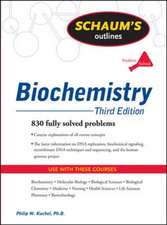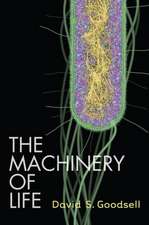Biochemistry of Dioxygen: Biochemistry of the Elements, cartea 4
Autor Lloyd L. Ingraham, Damon L. Meyeren Limba Engleză Paperback – 27 sep 2011
Din seria Biochemistry of the Elements
- 15%
 Preț: 647.08 lei
Preț: 647.08 lei - 5%
 Preț: 1620.56 lei
Preț: 1620.56 lei - 5%
 Preț: 1102.82 lei
Preț: 1102.82 lei - 18%
 Preț: 1222.94 lei
Preț: 1222.94 lei - 18%
 Preț: 946.72 lei
Preț: 946.72 lei - 15%
 Preț: 640.88 lei
Preț: 640.88 lei - 15%
 Preț: 642.83 lei
Preț: 642.83 lei - 15%
 Preț: 600.90 lei
Preț: 600.90 lei - 15%
 Preț: 646.75 lei
Preț: 646.75 lei - 5%
 Preț: 373.68 lei
Preț: 373.68 lei - 18%
 Preț: 1230.84 lei
Preț: 1230.84 lei - 15%
 Preț: 648.42 lei
Preț: 648.42 lei - 15%
 Preț: 649.71 lei
Preț: 649.71 lei - 5%
 Preț: 369.29 lei
Preț: 369.29 lei - 5%
 Preț: 720.47 lei
Preț: 720.47 lei
Preț: 640.71 lei
Preț vechi: 753.77 lei
-15% Nou
Puncte Express: 961
Preț estimativ în valută:
122.62€ • 127.54$ • 101.23£
122.62€ • 127.54$ • 101.23£
Carte tipărită la comandă
Livrare economică 14-28 aprilie
Preluare comenzi: 021 569.72.76
Specificații
ISBN-13: 9781461295013
ISBN-10: 1461295017
Pagini: 304
Ilustrații: 300 p.
Dimensiuni: 155 x 235 x 16 mm
Greutate: 0.43 kg
Ediția:Softcover reprint of the original 1st ed. 1985
Editura: Springer Us
Colecția Springer
Seria Biochemistry of the Elements
Locul publicării:New York, NY, United States
ISBN-10: 1461295017
Pagini: 304
Ilustrații: 300 p.
Dimensiuni: 155 x 235 x 16 mm
Greutate: 0.43 kg
Ediția:Softcover reprint of the original 1st ed. 1985
Editura: Springer Us
Colecția Springer
Seria Biochemistry of the Elements
Locul publicării:New York, NY, United States
Public țintă
ResearchCuprins
1. Introduction.- 1.1 Chemical Reactions of Dioxygen.- 1.2 Biological Reactions of Dioxygen.- 1.3 Reduction Products of Dioxygen.- 1.4 Dioxygen Enzymes.- 1.5 Oxygen-17 Nuclear Magnetic Resonance Spectroscopy of Oxygen.- References.- 2. Ground-State Dioxygen.- 2.1 Properties of Dioxygen.- 2.2 Reactions of Dioxygen.- 2.3 Chain Reactions of Dioxygen.- 2.4 Examples of Dioxygen Chain Reactions.- References.- 3. Singlet Dioxygen.- 3.1 Physical Properties and Generation.- 3.2 Detection of Singlet Dioxygen.- 3.3 Organic Reactions of Singlet Dioxygen.- 3.4 Singlet Dioxygen-Tocopherol Reaction.- 3.5 Metathesis.- 3.6 Phototaxis.- 3.7 Singlet Sigma Dioxygen.- Summary.- References.- 4. Superoxide Ion.- 4.1 Properties, Sources, and Stability.- 4.2 Detection of Superoxide Ion.- 4.3 Haber-Weiss Reaction.- 4.4 Detection of -OH Radicals.- 4.5 Reactions of Superoxide Ion with Organic Compounds.- 4.6 Superoxide Dismutase.- References.- 5. Dialkyl Peroxides.- 5.1 Introduction.- 5.2 Naturally Occurring Dialkyl Peroxides other than Prostaglandin Intermediates.- 5.3 Prostaglandin.- References.- 6. Catalases and Peroxidases.- 6.1 Catalase.- 6.2 Peroxidase.- 6.3 Mechanisms of Catalase and Peroxidase.- 6.4 Chloroperoxidase.- 6.5 Glutathione Peroxidase.- References.- 7. Dioxygen as a Terminal Oxidant and the Formation of Dioxygen.- 7.1 Fitness of Dioxygen as a Terminal Oxidant.- 7.2 Formation of Dioxygen.- References.- 8. Metal-Dioxygen Complexes.- 8.1 Metal-Dioxygen Bonding.- 8.2 Activation of Dioxygen.- 8.3 Classification of Metal-Dioxygen Complexes.- 8.4 Bonding vs. Oxidation.- References.- 9. Biological Iron Dioxygen Carriers.- 9.1 Hemoglobin and Myoglobin.- 9.2 Hemoglobin Models.- 9.3 Hemerythrin.- References.- 10. Hemocyanin: A Biological Copper Dioxygen Carrier.- 10.1 General Properties.- 10.2 Hemocyanin Models.- References.- 11. Oxidases.- 11.1 Introduction.- 11.2 Laccase.- 11.3 Ceruloplasmin.- 11.4 Ascorbic Acid Oxidase.- 11.5 Amine Oxidases.- 11.6 Galactose Oxidase.- 11.7 Cytochrome Oxidase.- 11.8 Xanthine Oxidase.- 11.9 D-Amino Acid Oxidase.- 11.10 Glucose Oxidase.- 11.11 Lactate Oxidase.- References.- 12. Flavin Monooxygenases.- 12.1 Introduction.- 12.2 Salicylate Hydroxylase.- 12.3 m-Hydroxybenzoate Hydroxylase.- 12.4 m-Hydroxybenzoate 4-Hydroxylase.- 12.5 p-Hydroxybenzoate Hydroxylase.- 12.6 Melilotic Hydroxylase.- 12.7 Phenol Hydroxylase.- 12.8 Orcinol Hydroxylase.- 12.9 Kynurenine 3-Hydroxylase.- 12.10 Imidazoylacetate Monooxygenase.- 12.11 Amine Oxidase.- 12.12 p-Cresol Methyl Hydroxylase.- 12.13 Mechanisms of Hydroxylation.- 12.14 Baeyer-Villiger Enzymes.- 12.15 Lactic Monooxygenase.- 12.16 Lysine Monooxygenase.- 12.17 Arginine Monooxygenase.- 12.18 Oxalic Acid Oxidase.- 12.19 Mechanism of Oxidative Decarboxylation.- References.- 13. Pterin Monooxygenases.- 13.1 Introduction.- 13.2 Phenylalanine Hydroxylase.- 13.3 Tyrosine Hydroxylase.- References.- 14. Copper Hydroxylases.- 14.1 Tyrosine.- 14.2 Dopamine-?-Hydroxylase.- References.- 15. Cytochrome P-450.- 15.1 Properties.- 15.2 Reaction Mechanisms.- 15.3 Model Studies.- 15.4 Oxides and Amine Dealkylation.- References.- 16. Other Iron Monooxygenases.- 16.1 Heme Oxidation.- 16.2 Tryptophan Side-Chain Oxidation.- 16.3 Indolyl-l,3-alkane ?-Hydroxylase.- References.- 17. Ribulose Bisphosphate Oxygenase.- 17.1 Introduction.- 17.2 Chemical Analysis.- 17.3 Effectors and Inhibitors.- 17.4 Reaction Mechanism.- References.- 18. Dioxygenases.- 18.1 Lipoxygenase.- 18.2 Lipoxygenase Mechanism.- 18.3 Other Lipoxygenases.- 18.4 Prostaglandin Synthetase.- 18.5 Pyrrolases.- 18.6 Tryptophan Dioxygenase.- 18.7Indoleamine 2,3-Dioxygenase.- 18.9 ?-Keto-Acid-Dependent Hydroxylases.- 18.10 2-Methyl-3-hydroxy-5-carboxy-pyridine Dioxygenase.- 18.11 Quercetinase.- 18.12 Benzene Dioxygenase.- References.- 19. Bioluminescence.- 19.1 General Concepts.- 19.2 Firefly Bioluminescence.- 19.3 Cypridina Bioluminescence.- 19.4 Bacterial Bioluminescence.- 19.5 Limpet Bioluminescence.- 19.6 Centipede Bioluminescence.- References.- 20. Dioxygen Toxicity.- 20.1 Introduction.- 20.2 Superoxide Toxicity.- 20.3 Measurement of Lipid Oxidation.- 20.4 Cytotoxic Compounds.- 20.5 Beneficial Functions of Dioxygen.- References.- 21. Further Chemistry of Singlet Dioxygen.- 21.1 A Word of Explanation.- 21.2 Reaction of Singlet Dioxygen with Olefins to Form Allylic Hydroperoxides.- 21.3 Concerted Cyclic Transition State Hypothesis in Allylic Hydroperoxides.- 21.4 Perepoxide Hypothesis.- 21.5 Diradical Hypothesis.- 21.6 An Alternative Hypothesis for Allylic Hydroperoxide Formation.- 21.7 Reaction of Singlet Dioxygen with ?,?-Unsaturated Diketones.- 21.8 Reaction of Singlet Dioxygen with Strained Acetylene.- References.










